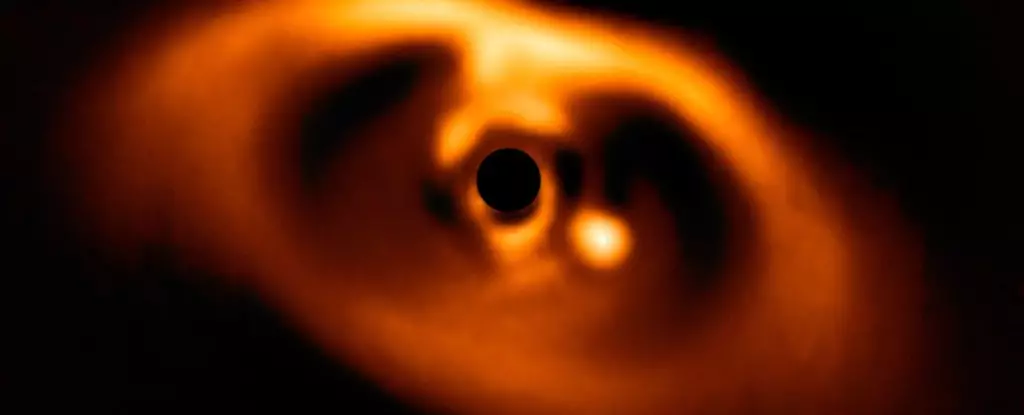The field of astronomy is currently undergoing a transformative phase marked by groundbreaking discoveries and new methodologies. As telescopes become increasingly advanced, aided by innovations in machine learning and imaging technology, astronomers are challenging longstanding theories regarding the formation of planetary systems. Traditionally governed by the Nebular Hypothesis, the understanding of how planets emerge from protoplanetary disks has faced scrutiny. This model posited that stars form from collapsing gas and dust within nebulae, leading to the consequent creation of surrounding planetary bodies. However, recent studies are bringing to light the nuances of planetary composition in ways that previous models did not account for, highlighting the complexity of planetary formation.
Groundbreaking Discoveries from PDS 70b
A team of astronomers led by Chih-Chun “Dino” Hsu from Northwestern University recently made a significant discovery that challenges these prevailing models. Their research, published in *The Astrophysical Journal Letters*, focused on a developing exoplanet, PDS 70b, located approximately 366 light-years from Earth. This particular planet presented a unique opportunity for investigation, as it exists within a protoplanetary disk—the region around a young star where planets are formed. The findings from this study revealed unexpected variations in the atmospheric composition of PDS 70b when compared to the molecular makeup of its surrounding disk, suggesting that the narrative about how planets are built is more intricate than previously believed.
The methodology employed in this research was commendable, utilizing the Keck Planet Imager and Characterizer (KPIC) at the W.M. Keck Observatory. By analyzing the light spectrum from PDS 70b, the research team was able to detect crucial elements such as carbon monoxide and water vapor in its atmosphere. The ability to extract detailed spectral data from a faint planet in close proximity to a much brighter star is a testament to the analytical power of modern astronomical tools.
Understanding the Carbon-to-Oxygen Ratio
One of the most surprising revelations from the research was the carbon-to-oxygen ratio in PDS 70b’s atmosphere, which was discovered to be significantly lower than that of the surrounding disk. Hsu and his colleagues had initially expected these ratios to align, based on the assumption that material in a planet’s atmosphere would mirror the composition of its disk. Instead, they found a divergence, prompting reflections on the underlying processes of planetary material acquisition. This observation calls into question long-held assumptions about the extent to which gaseous intake informs a planet’s composition.
The findings offered two potential explanations for this mismatch. Firstly, it is plausible that PDS 70b formed before its surrounding disk became rich in carbon, suggesting a temporal dimension to material accumulation that previous models had not fully integrated. Secondly, the research team speculated that PDS 70b may have primarily accreted solid materials, like ice or dust, rather than relying solely on gas accumulation. This distinction is critical because it indicates that solid physics might play a more substantial role in forming atmospheric characteristics than previously recognized.
The implications of this research extend far beyond the PDS 70 system, underscoring a broader necessity within the field of astronomy to reassess models of planetary formation. According to Hsu, the results underscore the inadequacies in the traditional understanding of how planets accumulate materials. If the processes that govern the acquisition of gases and solid materials during planet formation are not separated, researchers could continue to develop incomplete theories.
Jason Wang, the assistant professor of physics and astronomy who supervised the project, echoed these sentiments, emphasizing that methods for comparing gases alone may overlook critical contributions from the solid components of planet formation. This greater understanding reinforces the importance of comprehensive observations in astrophysics and the need for interdisciplinary approaches that account for the intricacies of astronomical phenomena.
The discoveries surrounding PDS 70b not only redefine our grasp of planet formation but also set the stage for future explorations. The research team plans to investigate another emerging exoplanet in the PDS 70 system, PDS 70c, to further analyze the contrasting atmospheric conditions between the two bodies. These studies will potentially provide deeper insights into the history and evolution of the entire system, unraveling the complex tapestry of planetary formation.
The findings from Hsu and his colleagues illustrate the power of modern technology in reshaping our comprehension of the universe. The era of shifting paradigms is upon us, and each new discovery pushes us closer to unraveling the mysteries of planetary systems, urging astronomers to reconsider what they think they know about cosmic birth and evolution. As we delve deeper into the mechanics of formation and atmospheric composition, the ability to reframe and refine our knowledge becomes increasingly vital. The quest for understanding continues, and we stand on the brink of exciting discoveries that may fundamentally change our perspective on the cosmos.

